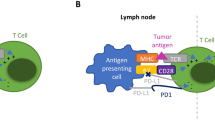Summary
The recent advent of immune checkpoint inhibitors (ICI), including anti-programmed cell death 1 protein (anti-PD-1) agents has revolutionized the therapeutic approach of metastatic malignancies. Yet, ICI can disrupt immune tolerance resulting in enhanced immune activation in normal tissues with significant toxicity. A dysregulated activation of T-cells directed to normal tissues stands as the main mechanism of immune-related adverse events (irAE). To date, only two cases of immune-related inflammatory orbitopathy related to anti-PD-1 agents have been reported. This rare immune adverse event usually occurred early after ICI initiation. Here, we report the first case of late inflammatory orbitopathy occurring in a melanoma patient treated with pembrolizumab. Consequently, the occurrence of irAE under ICI should be monitored, even late after treatment instauration.


Similar content being viewed by others
References
Boutros C, Tarhini A, Routier E, Lambotte O, Ladurie FL, Carbonnel F et al (2016) Safety profiles of anti-CTLA-4 and anti-PD-1 antibodies alone and in combination. Nat Rev Clin Oncol 13(8):473–486
Zimmer L, Goldinger SM, Hofmann L, Loquai C, Ugurel S, Thomas I, Schmidgen MI, Gutzmer R, Utikal JS, Göppner D, Hassel JC, Meier F, Tietze JK, Forschner A, Weishaupt C, Leverkus M, Wahl R, Dietrich U, Garbe C, Kirchberger MC, Eigentler T, Berking C, Gesierich A, Krackhardt AM, Schadendorf D, Schuler G, Dummer R, Heinzerling LM (2016) Neurological, respiratory, musculoskeletal, cardiac and ocular side-effects of anti-PD-1 therapy. Eur J Cancer 60:210–225
Lecouflet M, Verschoore M, Giard C, Gohier P, Le Corre Y, Milea D et al (2013) Orbital myositis associated with ipilimumab. Ann Dermatol Venereol 140(6–7):448–451
McElnea E, Ní Mhéalóid A, Moran S, Kelly R, Fulcher T (2014) Thyroid-like ophthalmopathy in a euthyroid patient receiving Ipilimumab. Orbit Amst Neth 33(6):424–427
Borodic G, Hinkle DM, Cia Y (2011) Drug-induced graves disease from CTLA-4 receptor suppression. Ophthal Plast Reconstr Surg 27(4):e87–e88
Min L, Vaidya A, Becker C (2011) Thyroid autoimmunity and ophthalmopathy related to melanoma biological therapy. Eur J Endocrinol 164(2):303–307
Sheldon CA, Kharlip J, Tamhankar MA (2017) Inflammatory Orbitopathy associated with Ipilimumab. Ophthal Plast Reconstr Surg 33:S155–S158
Nasr F, El Rassy E, Maalouf G, Azar C, Haddad F, Helou J et al (2018) Severe ophthalmoplegia and myocarditis following the administration of pembrolizumab. Eur J Cancer Oxf Engl 1990 91:171–173
Campredon P, Imbert P, Mouly C, Grunenwald S, Mazières J, Caron P (2018) Severe inflammatory Ophthalmopathy in a Euthyroid patient during Nivolumab treatment. Eur Thyroid J 7(2):84–87
Alnabulsi R, Hussain A, DeAngelis D (2018) Complete ophthalmoplegia in Ipilmumab and Nivolumab combination treatment for metastatic melanoma. Orbit Amst Neth 30:1–4
Bartalena L, Marcocci C, Gorman CA, Wiersinga WM, Pinchera A (2003) Orbital radiotherapy for Graves’ ophthalmopathy: useful or useless? Safe or dangerous? J Endocrinol Investig 26(1):5–16
Mombaerts I, Koornneef L (1997 Mar) Current status in the treatment of orbital myositis. Ophthalmology 104(3):402–408
Ueda H, Howson JMM, Esposito L, Heward J, Snook H, Chamberlain G et al (2003) Association of the T-cell regulatory gene CTLA4 with susceptibility to autoimmune disease. Nature 423(6939):506–511
Chistiakov DA, Turakulov RI (2003) CTLA-4 and its role in autoimmune thyroid disease. J Mol Endocrinol 31(1):21–36
Han S, Zhang S, Zhang W, Li R, Li Y, Wang Z, Xie Y, Mao Y (2006) CTLA4 polymorphisms and ophthalmopathy in Graves’ disease patients: association study and meta-analysis. Hum Immunol 67(8):618–626
Weber JS, Hodi FS, Wolchok JD, Topalian SL, Schadendorf D, Larkin J et al (2017) Safety profile of Nivolumab monotherapy: a pooled analysis of patients with advanced melanoma. J Clin Oncol Off J Am Soc Clin Oncol 35(7):785–792
Author information
Authors and Affiliations
Corresponding author
Ethics declarations
Conflicts of interest
The authors do not have any disclosure.
Ethical approval
All procedures performed in studies involving human participants were in accordance with the ethical standards of the institutional and/or national research committee and with the 1964 Helsinki declaration and its later amendments or comparable ethical standards.
Informed consent
Informed consent was obtained from the patient.
Rights and permissions
About this article
Cite this article
Nardin, C., Borot, S., Beaudoin, MA. et al. Long-term adverse event: inflammatory orbitopathy induced by pembrolizumab in a patient with metastatic melanoma. Invest New Drugs 37, 375–377 (2019). https://doi.org/10.1007/s10637-018-0659-9
Received:
Accepted:
Published:
Issue Date:
DOI: https://doi.org/10.1007/s10637-018-0659-9




